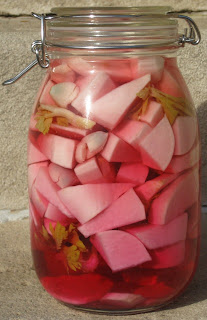 Apple butter is just a hop, skip and jump from applesauce. So if you already know how to make applesauce, you are just a couple of steps from having apple butter.
Apple butter is just a hop, skip and jump from applesauce. So if you already know how to make applesauce, you are just a couple of steps from having apple butter.There's no dairy in apple "butter." But it is thicker and darker than apple sauce--another of the thousand or so uses for apples our forebears came up with when apples were such an important part of the diet.
If you are looking for ways to store from the fall harvest, apple butter is a genius stroke as it can easily be canned and stashed in the pantry.
Use a flavorful, cooking-type apple such as Winesap or Jonathan. We chose Mountaineers from nearby West Virginia and Macintosh. For this recipe, you do not remove the skin of the apple (lending some pectin to help thicken the final product) but you do remove the stems and cores. A couple of helpful pieces of equipment are a food mill, as shown in the picture above, and a splatter screen for covering your cook pot.
To make four pints apple butter:
5 pounds apples, cored and cut into eight wedges each (skin on)
1 cup apple cider

1 1/4 cups granulated sugar
1 1/4 cups brown sugar
1/2 teaspoon cinnamon
1/4 teaspoon ground cloves
1/4 teaspoon nutmeg
Place apples and cider in a heavy pot, cover and bring to a boil over moderately high heat. Reduce heat and simmer until apples are soft, about 10 minutes.
Process the cooked apples finely through a food mill. Pour the apple puree back into the cook pot and mix with sugars and spices. (Note: use 1/4 cup sugar for each cup of puree). Bring to a boil, then reduce heat and continue cooking uncovered, stirring frequently and scraping the bottom of the pot so that the puree does not scorch. Keep in mind that the thick puree, rather than quietly bubbling, tends to burp and burst and send hot material flying into the air. This is where a splatter screen over your pot comes in handy. You don't want a big mess, but you do want the moisture to evaporate so the puree can thicken.
Continue cooking for an hour or more, until the apple puree has thickened and caramelized to a nutty brown. It should mound up in a spoon.
Now you can ladle the hot apple butter into sterile pint jars. Seal the jars and process in a boiling water bath for 10 minutes.
The kids in our "food appreciation" classes had great fun cutting the apples and grinding away at the food mill. Our treat was spreading the finished apple butter on slices sweet potato bread, freshly baked from some of the sweet potatoes recently harvested from our garden. Talk about a tasty snack for fall....










































 For our wedding reception about a century ago, my wife and I presented an October buffet with tons of pickled and preserved items. One of them was eggplant thinly sliced and preserved with layers of garlic, red pepper flakes, basil leaves, red wine vinegar and olive oil. Normally, my wife's not a big fan of eggplant. But she makes an exception for this.
For our wedding reception about a century ago, my wife and I presented an October buffet with tons of pickled and preserved items. One of them was eggplant thinly sliced and preserved with layers of garlic, red pepper flakes, basil leaves, red wine vinegar and olive oil. Normally, my wife's not a big fan of eggplant. But she makes an exception for this.











